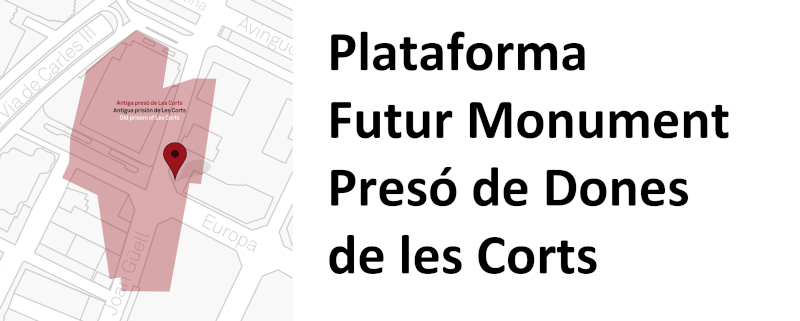This second phase of the exposition featured some of the testimonies preserved from Les Corts former inmates: those of Maria Salvo, Isabel Vicente, Victòria Pujolar, Laia Berenguer, Soledad Real, Carme Claramunt, Enriqueta Gallinat, and Tomasa Cuevas, to name a few. The intensity provided by these personal accounts greatly enhances the memorial character of the site.
On the 14th of April of that year, an event was organised to pay tribute to the prisoners—and to their sons and daughters—who had been the victims of repression at Les Corts, with hundreds of people attending.
The act was closed by the theatrical performance Les Veus de Les Corts (‘The Voices of Les Corts’), first presented by Memòria Silenciada during the international seminar that was held the year before.
The display panels of the temporary site of memory at the intersection of Joan Güell and Europa streets were changed again in November 2015.
A segment from Ildefons Cerdà’s topographical plan of 1855 coinciding with that area of Les Corts was used as a base over which eight planimetric maps were superimposed in chronological order, revealing the transformation of the tract of land the old prison once stood upon.
This presentation (the 3rd one) lasted until May 2019.
New signposts were placed in the space of the temporary site during a workshop to show the connections that existed between Les Corts prison and the Camp de la Bota, the place where, in the post-war years, most of the mass executions carried out by the Francoist government occurred.
12 women from Les Corts were executed on the sandy grounds of Camp de la Bota, out of a total number of over 1.700 people who were killed there between 1939 y 1952. Their bodies, as was usually done with the men, were taken to Fossar de la Pedrera (Quarry Grave), a mass grave on the grounds of Montjuïc Cemetery.
In November these two landmarks, 8 km apart on a straight line along Diagonal Avenue, were linked together, with the employment of the same signposting the municipality of Barcelona has had in use over the last few years, singled out by the application of specific colours.
This initiative was the implementation, slightly modified, of one of the projects devised as part of the Master in Urban Design of the University of Barcelona for the year 2014, authored by Pablo F. Marmissolle, Frida Marín and Isabel Navas.
On 12 November, a bus called Bus Memoria (‘Memory Bus’) travelled from Les Corts to Campo de la Bota during the inauguration of the new signposting, bringing together women from the districts of Sant Martí, Nou Barris, Les Corts (Barcelona) and the city of Sant Adrià de Besòs.
Thanks to that common experience the Platform Future Monument Les Corts Women’s Prison enjoyed a considerable development with regards to the expansion of the network of agencies that were getting involved in the project across the metropolitan area.















